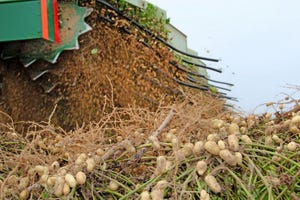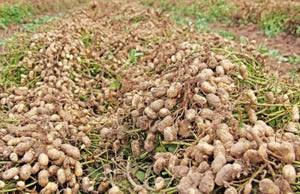
Although there are still too many peanuts overhanging the market from bumper U.S. crops in 2012 and 2013, U.S. producers may increase acreage this year because alternate crops don’t hold much promise for better returns.

MARSHALL LAMB
“This is going to be a year in which growers have to make the right decisions about what to plant — and that’s going to be very difficult to do,” says Marshall Lamb, who’s research leader at the USDA/ARS National Peanut Research Laboratory at Dawson, Ga.
“If we have more peanut acres this year and another high average yield, we’ll have another large carryout going from 2014 into 2015, there will be another oversupply, and prices will be low again in in 2015,” he said at the annual meeting of the Mississippi Peanut Growers Association at Hattiesburg.
Ag news delivered daily to your inbox: Subscribe to Delta Farm Press Daily.
A look at estimated breakeven prices for key southern crops shows the dilemma facing growers.
“For 4,600 pound irrigated peanuts, breakeven [based on Georgia budgets] is $440 per ton; for 200 bushel irrigated corn, breakeven is $4.50 per bushel; for 1,150-pound irrigated cotton, breakeven is 80 cents per pound; and for 57 bushel irrigated soybeans, breakeven is $11.57 per bushel.”
Thus, irrigated corn would equate to $400 per ton peanuts; 80-cent cotton would equate to $453 per ton peanuts; soybeans at $12.41 per bushel would equate to $426 per ton peanuts; and double-cropped wheat/soybeans would equate to $465 peanuts.
“Although I’m not aware of any peanut contracts being offered today, I heard of some earlier at 22 cents per pound, or $440 per ton,” Lamb says. “So, that would make peanuts competitive for acres with corn, cotton, and soybeans.”
While no one can predict the vagaries of growing season weather, or conditions in competing countries, he says the potential is for growers in the U.S. Midwest to do what they do every year — plant a lot of corn and soybeans.
“And it’s what Midwest growers do that has the greatest influence on corn and soybean prices — not what we do here in the Southeast. With their potential to produce a lot of corn for a market that’s already in surplus, as well as a lot of soybeans, the outlook is not bright for significant price appreciation in either of those crops.”
Which means southern farmers, who’ve been riding the corn/soybean boom in recent years and who have the option of growing peanuts, may elect to plant more of that crop this year.
Impact of Midwest crop decisions
Corn/soybean production costs for Midwest farmers have risen significantly, Lamb notes, which makes it all the more critical that they produce high yields in order to cover costs.
“Illinois Farm Business Management Association figures, based on grower data, show their total cost per acre of growing corn has gone up from $400 in 2004 to $800-plus in 2013. Some of that is related to higher energy and nitrogen costs, but total input costs have risen from $172 per acre to $372.
“With skyrocketing Midwest farmland prices, their land costs — whether rented or owned — have gone from an average $140 per acre to $276 per acre.

TOM MABRY, left, Agri-AFC, Hattiesburg, Miss., and Josey Breland, Petal, Miss., producer, were among those attending the peanut conference.
“For corn, their breakeven price over variable cost has gone from about $2 per bushel in the mid-2000s to $4.31-$4.65 per acre now. Corn prices today are around $4.50, which can put a big squeeze on a lot of Midwest growers.”
The same trend holds for the region’s soybean producers, Lamb says. “Their cost of production went from $300 per acre in mid-2000s to $548 in 2013. Inputs went from $90 per acre to $163, and land costs doubled to $276.
“This also puts them in a very tight situation in terms of breakeven. Their breakeven price, over variable costs, has skyrocketed from the $5-6 per bushel range to $10-$11. Today, we’re looking at around $11 per bushel for soybeans, so it’s going to be very difficult for these producers.”
For all the major U.S. crops, Lamb says, the overriding influence on markets is the supply-demand ratio.
While USDA’s stocks-to-use ratios for U.S. corn, soybeans, and cotton have remained fairly flat for the 2011-13, period, they have risen globally, reflecting greater supplies worldwide, he says.
“Stocks-to-use ratios are getting back to more normal levels, and markets are correcting for that. With prices for grains as high as they’ve been, we had to know that eventually they would come back down —markets always adjust themselves, and that’s what we’re going through right now. For a lot of people, particularly for Midwest growers with high per acre costs, it may be tough to get through this.”
Door closes on China's purchases
For 2014, peanut exports are expected to be down, Lamb says, after 2013 got a boost from unexpected purchases by China — itself a major grower of peanuts, but increasingly less of an exporter.
“In 2002, China owned about 50 percent of the world peanut export share,” Lamb says. “They were the dominant exporter. But by 2007, they were at 36 percent — a 14 percent drop over five-year period. By 2012, they had dropped to 21 percent.
“China is still growing a lot of peanuts. They’re just not exporting as much of their crop; they’re using more internally.”
India has become a key player in the peanut export market, he notes, and the major supplier of peanuts to China.

WITH THE REBOUND in India's peanut production, "the door has basically slammed shut" on U.S. peanut exports to China, says Marshall Lamb.
“When India’s monsoonal rains failed in 2013, they weren’t able to supply quality peanuts to China. The U.S. was sitting on a huge crop of high quality peanuts, at an attractive price, and China started buying from us. Everyone thought that was going to be more business than finally developed.
“Since then, India’s monsoon has returned to normal, they’ve had one good crop, and are in the process of producing another. And the door to China has basically slammed shut on purchases of U.S. peanuts. Unless something goes wrong with India’s crop, I don’t think China holds much opportunity for us in the immediate future.”
Since the 2002 farm bill, Lamb says, “U.S. peanuts have been on an up-and-down two-year cycle of oversupply and undersupply. I don’t think we’re going to be able to get out of this cycle — we’re going to have to learn to deal with it.”
A carryout at the end of the peanut marketing year (July 31) is considered generally healthy at between 500,000 and 600,000 farmer stock tons, he says.
After the huge 2012 crop, the carryout going into the 2013 marketing year was 1.2 million to 1.3 million farmer stock tons, “a very depressing number; we had increased carryout threefold in just one year.
“Then, we produced 2.1 million farmer stock tons in 2013, and with the carryout, we had a 3.4 million ton working supply. While 2013 demand was up a bit as a result of the Chinese purchases, basically we were looking at a 1.1 million ton carryout going into 2014. So, once again we’ve oversupplied the market.”
Huge crops depress prices
Peanut prices, Lamb says, “have really been bouncing around in recent years. In 2011, because of the drought in the Wiregrass area of Alabama and in southwest Georgia, prices really shot up. Uncontracted peanuts at the end of the year were bringing roughly $1,000 per ton, and going into 2012, when we were in a deficit supply situation, offers came out over $700 per ton, which led to large increases in acreage.

In 2013 U.S. peanut growers planted the smallest acreage since the 1920s, but still produced a 2.137 million ton crop.
“Yields in 2012 were tremendous, averaging 4,117 pounds. That led to more oversupply and lower prices, and in 2013 we planted the smallest acreage since the 1920s, but still produced a 2.137 million ton crop. We’ve had absolutely phenomenal yields back-to-back.”
Those yields dwarf historical levels, Lamb notes. “From the 1920s through the 1950s, we were producing only about 700 pounds per acre. Then we saw a tremendous improvement in the ‘70s, ‘80s, and ‘90s, when Florunner peanuts were introduced.”
In the 2000-2009 period, as varieties continued to improve, the U.S. averaged over 3,000 pounds per acre, and in the last four crop years over 3,700 pounds per acre.
“It has been impressive,” Lamb says, “to be in an industry and see that kind of growth in per acre output, thanks to improved varieties, improvements in technology and production methods, and better management from our growers.”
For 2014, with more peanut acres likely and contract offers in the $400 neighborhood, he tells growers: “Anything you can do to keep your overhead low, this will be the year to do it. Try to manage production costs to the degree that you can.”
But, Lamb says, “Be careful and don’t overdo it, because you can often do more harm, economically and yield-wise, than good.
“I don’t know many farmers who are throwing money away on production costs — and there’s the very real danger you can cut too much and hurt yourself.”
About the Author(s)
You May Also Like




